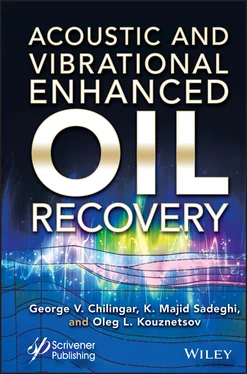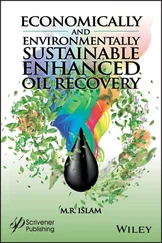George V. Chilingar - Acoustic and Vibrational Enhanced Oil Recovery
Здесь есть возможность читать онлайн «George V. Chilingar - Acoustic and Vibrational Enhanced Oil Recovery» — ознакомительный отрывок электронной книги совершенно бесплатно, а после прочтения отрывка купить полную версию. В некоторых случаях можно слушать аудио, скачать через торрент в формате fb2 и присутствует краткое содержание. Жанр: unrecognised, на английском языке. Описание произведения, (предисловие) а так же отзывы посетителей доступны на портале библиотеки ЛибКат.
- Название:Acoustic and Vibrational Enhanced Oil Recovery
- Автор:
- Жанр:
- Год:неизвестен
- ISBN:нет данных
- Рейтинг книги:5 / 5. Голосов: 1
-
Избранное:Добавить в избранное
- Отзывы:
-
Ваша оценка:
Acoustic and Vibrational Enhanced Oil Recovery: краткое содержание, описание и аннотация
Предлагаем к чтению аннотацию, описание, краткое содержание или предисловие (зависит от того, что написал сам автор книги «Acoustic and Vibrational Enhanced Oil Recovery»). Если вы не нашли необходимую информацию о книге — напишите в комментариях, мы постараемся отыскать её.
Oil and gas is still a major energy source all over the world, and techniques like these, which are more environmentally friendly and inexpensive than many previous development and production technologies, are important for making fossil fuels more sustainable and less hazardous to the environment. Based on research they did in the 1970s in Russia and the United States, the authors discovered that oil rate production increased noticeably several days after the occurrence of an earthquake when the epicenter of the earthquake was located in the vicinity of the oil producing field. The increase in oil flow remained higher for a considerable period of time, and it led to a decade-long study both in the Russia and the US, which gradually focused on the use of acoustic/vibrational energy for enhanced oil recovery after reservoirs waterflooded. In the 1980s, they noticed in soil remediation studies that sonic energy applied to soil increases the rate of hydrocarbon removal and decreases the percentage of residual hydrocarbons. In the past several decades, the use of various seismic vibration techniques have been used in various countries and have resulted in incremental oil production. This outstanding new volume validates results of vibro-stimulation tests for enhanced oil recovery, using powerful surface-based vibro-seismic sources. It proves that the rate of displacement of oil by water increases and the percentage of nonrecoverable residual oil decreases if vibro-energy is applied to the porous medium containing oil. Audience:
Petroleum











 tends to δ ( τ )/2 at λ → 0. The Green function G α( t,r ) shown in Equation (2.15)converges in this case to a simple Green function of the classical wave differential equation, i.e., to
tends to δ ( τ )/2 at λ → 0. The Green function G α( t,r ) shown in Equation (2.15)converges in this case to a simple Green function of the classical wave differential equation, i.e., to  . The solution at α = 1/2 may be presented in a simple explicit format:
. The solution at α = 1/2 may be presented in a simple explicit format:




 . These parameters are determined from the density of vibratory energy flow E at a given point of the medium and through vibration frequency f as follows:
. These parameters are determined from the density of vibratory energy flow E at a given point of the medium and through vibration frequency f as follows:











